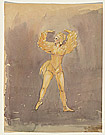Le Coq d'Or [The Golden Cockrel]
- Producer: 1914 Les Ballets Russes de Serge Diaghilev
- 1937 Ballets Russes de Col W de Basil
- Premiere: 24 May 1914, Théâtre national de l’Opéra, Paris
- Revival: 23 September 1937, Covent Garden, London
- Costume design: Natalia Goncharova
- Costumier: 1937 Barbara Karinska
- Scenery design: Natalia Goncharova
- Music: Nikolai Rimsky-Korsakov, adapted by Nicholas Tcherepnin
- Choreography: Michel Fokine
- Libretto: Vladimir Belsky, after Aleksandr Pushkin,
revised by Alexandre Benois - Main characters: The Queen of Shemakhan, King Dodon, the Golden Cockerel, Astrologer, General Polkan, Amelfa, Prince Aphron, Prince Guidon
Set in ancient Azerbaijan, this moral tale tells of an astrologer who has caught and enchanted a golden cockerel which he presents to King Dodon. The king, unsure of how to properly govern his kingdom, requests the advice of his two sons. Prince Guidon encourages a life of frivolity, while Prince Aphron advocates war with their neighbouring kingdom. However, the astrologer’s gift of the golden bird means that the lazy king can instead sleep, while the cockerel watches over the city. The king promises the astrologer a gift of anything he desires. The cockerel wakes Dodon to alert him of danger and in response he sends both his sons to war before falling back asleep. The cockerel wakes Dodon again and this time the king himself goes to war, where he finds both his sons dead on the battlefield. However, his grief is short-lived as he comes across the tent of the Queen of Shemakhan, with whom he promptly falls in love. He returns to his kingdom with her as his bride but the astrologer asks for her as his promised gift. Dodon refuses and beats the astrologer to death for his impertinence. The cockerel then swoops down and strikes the king on the head, killing him, and magically the queen and the cockerel disappear. The astrologer then comes back to life to explain the moral of his tale.
Natalia Goncharova, already an extraordinary modern painter, drew her complex neo-primitivist fantasy of a traditional Russian city for the stage set of Le Coq d’or
in 1914. Layers of onion domes, striations of red, pink and yellow, bold square blocks and perfectly geometrical buildings made up the backdrop for this Russian fairy tale. Although designed by a modernist artist, with modern music by Stravinsky, this production looked to a world already disappearing, soon to be imagined only outside Russia. Goncharova’s interpretation of the conventions, patterns and colours of traditional Russian folk dress, popular lubok prints and crafts, deliberately linked the high-key colours and abstracted shapes of the costumes to the backdrops, creating an overall spectacle of Byzantine richness and complexity.



![Adrian FEINT | The Queen of Shemakhan in ballet 'Le coq d'or' [recto] |](images/sml/57965.jpg)










